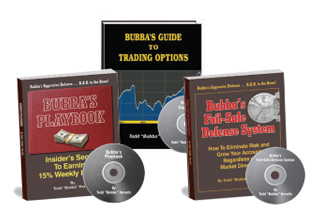.jpg)
Follow
Us:    
|
|
|
Todd “Bubba” Horwitz is what you call “street smart”. When something screwy happens in any of the markets... stock, futures, options... Bubba is the first person media giants like Fox Business News and CNBC call. And when nothing’s happening, they call him then too. Top fund managers with as much as $8-Billion under management go to Bubba for guidance in safeguarding their portfolios against downside risk. And thousands of men & women schooled by Bubba enjoy security and peace of mind knowing even a modest IRA can produce a generous monthly income while continuing to grow risk-free forever.
 |
Bubba’s Aggressive Defense
Is B.A.D. to the Bone!

Bubba’s Aggressive Defense, B.A.D. for short, turns the tables on greedy market manipulators...
Empowering you to earn a steady income when the markets are quiet...
Exploit wild price swings for triple-digit gains when things heat up...
And most important: preserve, protect and grow your nest egg regardless of market conditions.
So, instead of worrying about ever running out of money... you can potentially spend money until your heart’s content and still leave $millions to your heirs!
Learn More About
B.A.D. to the Bone
|
|

Better
Business Bureau
 |
|
Click on authors name
to learn more
|
| |
|
|
Inside Trading this week features an article from Todd “Bubba” Horwitz. Bubba walks us through the life cycle of an option.
Next, Lee Gettess gives us his weekly analysis of the S&P and bond markets.
Then, Tom DeMark explains how buy and sell signals are used in his Sequential™ trading system.
Last, Andy Chambers presents his Weekly Market Line in the Sand newsletter.
Enjoy!
Adrienne LaVigne
TradeWins Publishing
 |
|
The Option Life Cycle
by
Todd Horwitz
The following
is an excerpt from Todd "Bubba" Horwitz's Bubba’s Guide to Trading Options
Options are priced differently than any other class of assets. The auction market is still the mechanism used to discover price, however volatility (implied volatility) will determine the normal price at any point in time.
Visualize the option model to be a balloon attached to the spot, or market price of an asset, in this case a stock. As you pump air into the balloon it expands equally in all directions. The more air added, the bigger the balloon’s expansion. Think of the air going into the balloon as option “premium”. This is the amount that buyers are willing to pay over the “intrinsic value” to own an option at a particular strike price.
If we were to suck all of the air out of the balloon, the option price would fall back to a specific “flat” cost relative to the underlying asset (current market price of our stock). The option model expands in all directions. The longer time to expiration OR the higher the volatility (more “air”) for an option with an At-The-Money (ATM) strike price – which has no intrinsic value – the option’s absolute value (price) at all strike prices would be higher.
The Option Life Cycle
|
Lee
Gettess' Market Sense
by Lee Gettess
Lee
Gettess is a top trader who is excited
to bring you his video newsletter.
Each week, Lee will share his predictions
on what he anticipates from the bond
and S&P markets.
Watch
Video
|
Sequential: Countdown, Entry and Exit
by Thomas DeMark
The following
is an excerpt from Tom DeMark's The New Science of Technical Analysis
My research confirms the fact that, prior to a price top or bottom, the market announces its intentions regarding price direction loud and clear to any trader willing to listen. Specifically, the market forewarns the trader whether it is predisposed toward a price top or toward a price bottom. In other words, the market’s environment or inclination to top or to bottom is first defined by the setup phase. Because my entire approach is mechanical, as are the additional filters required to actually generate the buy and sell signals, I developed a checklist to simplify this process. The feature of this approach is its design to buy into weakness and to sell into strength. Once all the prerequisites are satisfied in the order required, a signal occurs. Hence, the name Sequential™ was given to the system.
Countdown
Once your setup has been satisfied, the countdown process begins. Countdown describes the relationship of the close to either the high or the low price two trading days earlier, depending on whether a sell or a buy setup is active. With respect to a pending buy signal, the close must be less than the low two days earlier; with respect to a pending sell signal, the close must be greater than the high two trading days earlier. Once a total of 13 closes less than the low two trading days earlier (in the case of a buy), or a total of 13 closes greater than the high two trading days earlier (in the case of a sell) are recorded, a signal is generated.
Sequential: Countdown, Entry and Exit
|
Weekly Market Line in the Sand
by Andy Chambers
The following is an excerpt from Andy Chambers' Weekly Market Line in the Sand
Every week Andy publishes his “Weekly Market Line in the Sand” newsletter. The following are trade updates from his most recent issue.
DOW Futures Weekly: The upside breakout in the Mini Dow futures points to a further advance. The current targets are 20,000 and 22,500. The market appears to be overbought on a weekly basis. Corrections are expected to yield to buying opportunities. A weekly close below 17,418 would put the bullish outlook on hold.
DIA Weekly: The bullish breakout points to a further advance. The initial targets are 200 and 210. The market appears to be overbought on a weekly basis. Corrections are expected to yield to buying opportunities. A weekly close below 178.64 would put the bullish outlook on hold.
To Learn More Click Here
|
|